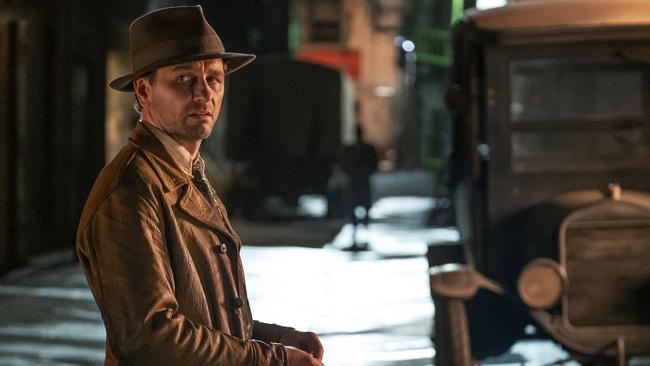Straight from the pulps, it’s Perry Mason with an edge
America couldn’t get enough of Erle Stanley Gardner’s crime stories in the 1930s. Now Matthew Rhys takes on the role.

Many of us will remember the TV series Perry Mason, starring Raymond Burr as the fictional Los Angeles criminal defence lawyer who never lost a case; the character created by crime writer Erle Stanley Gardner. The courtroom drama, Hollywood’s first hour-long TV production, remains one of TV’s most successful shows running from 1957 to 1966, filmed by Gardner’s company, Paisano Productions. It was then revived in various iterations.
Mason would defend the wrongly accused, with the help of his private investigator, Paul Drake, and his secretary, Della Street, then sensationally reveal during an evidentiary hearing how the justice system screwed up, his client released by episode’s end.
Now after a 10-year development, Mason is back in reimagined form in a series created by Ron Fitzgerald and Rolin Jones, producers of the splendid Friday Night Lights. The drama was originally developed for HBO by True Detective’s Nic Pizzolatto, with Robert Downey Jr producing and starring as Perry Mason. Downey Jr returns to the project with his producer wife, Susan, with Jones and Fitzgerald also acting as co-producers, showrunners and writers.
The estimable Timothy Van Patten, whose stunning resume includes the opening episode of Game of Thrones, alongside episodes of The Sopranos, Deadwood, The Wire, Boardwalk Empire and The Pacific, is the director. A former actor, Van Patten is not only good with all the tricks and cinematic hijinks that now characterise high-end TV but one of those directors who is good with actors, especially in the crucial small scenes that establish character or mood.
Behind the camera is distinguished French-born cinematographer David Franco, who has filmed some of the great series in this golden age of TV drama, including The Bridge, Desperate Housewives, Boardwalk Empire, Game of Thrones and Vinyl. The busy Franco won an Emmy for HBO’s original movie, Bury My Heart at Wounded Knee.
And judiciously cast as Mason is The Americans star Matthew Rhys, who is so good at finding the gravity in the lives of troubled men. And his Mason, at least by the end of the first episode — the show is set in early 1930s Los Angeles, a city quickly growing from a backwater to a full-on metropolis — is little like the urbane, beautifully attired, articulate Mason of the earlier TV series. He’s much closer to the way Gardner originally conceived him in 1933 at the start of The Case of the Velvet Claws, his first Mason novel: “He gave the impression of being a thinker and a fighter, a man who could work with infinite patience to jockey an adversary into just the right position, and then finish him with one terrific punch.”
And Rhys’s Mason is straight out of the pulps, the popular crime magazines that nurtured Gardner at the start of his career in the 1930s; bitter, pugnacious, marginal and lonely. And paranoid, the law itself an impediment to the accomplishment of any true justice in LA. “Everyone’s up to something; everyone’s got an angle; hiding something; and everyone is guilty,” he says towards the end of the first episode. (“Our Mason is more of a gritty fixer than a polished lawyer; more Bogart than Burr,” Fitzgerald says.)
He’s hired by his occasional employer, the ebullient trial lawyer EB Jonathan, played with a lovely irascible edge by John Lithgow, to investigate the horribly bungled kidnapping of a young child. It’s a shocking case, exciting the media, a Los Angeles Examiner newspaper headline reading, “Horror at Angel’s Flight”.
The real client is Robert Patrick’s stone-faced Herman Baggerly, a patrician figure in LA, a major player, Mason is told, in lumber and real estate, and “with one of the fattest bank accounts in the city”. Baggerly belongs to the same Pentecostal church, the Radiant Assembly of God, as Emily and Matthew Dodson, parents of the kidnapped child. “God has put you in their path,” he tells Mason. (The failed attempt starts the drama off in spectacular noir style, Van Patten transforming reality to create mood, heightening angles and creating an almost delirious energy.)
And, as he becomes involved, Mason’s quest for answers takes on a moral dimension, his toughness forming a protective aura guarding the essence of his essentially quixotic character. As Della Street, Jonathan’s brainy legal secretary, played with wonderful composure and a measure of gleeful wit by Juliet Rylance, says to Mason, “So many windmills, so little time”.
Of course, this being hard-boiled territory, the law inefficient and susceptible to corruption, Mason’s investigation is shot through with undertones of assault, betrayal and danger. The kidnapping case is a big one and he doesn’t usually do “the bigs” — as one of the mendacious cops officially involved says. He normally survives, “feeding off runaways and cheaters”. He scratches out a living trailing misbehaving screen stars, like corpulent comic Chubby Carmichael (Bobby Gutierrez) usually in the company of a sidekick, the tough, flashy Pete Strickland, played with comic intensity by Shea Whigham, then selling lewd pics of them to the tabloids.
He lives in a dilapidated dairy once owned by his parents in the middle of a small airport, estranged from his wife and young son, the clothes he wears once owned by the dead, bribing officials at the city morgue for his apparel. His girlfriend is the formidable Lupe, the hard-drinking aviatrix and air speed champion, terror of the Californian skies. This is a fabulous scene-stealing performance by Veronica Falcon, so good in Mexican drama Queen of the South, as the ruthless Camilla, queen of the cartels, running her consignments across the border into Texas.
She watches as Mason quickly becomes deeply involved in the investigation, a case already bungled by the cops, driven by a sense that this could transform his life, and the pressure against his involvement becomes increasingly violent.
Even his capture of the photographs of Chubby Carmichael’s salacious sexual encounter with an up-and-coming starlet — a parallel plot it seems — leaves him wounded, badly burned by the heated-up barrel of his own revolver. (It’s a terrific scene. Mason is helpless before some kind of enforcer and his thugs, protecting the interests of the new Hollywood studios; it’s brutish and slightly surreal at once.)
As yet he’s no detective with transcendent powers of observation but his commonness, scruffiness and bitterness are nonetheless a mask for obviously some uncommon powers. This seemingly frustrated and cynical failure knows how to handle himself with violence. He’s a war veteran after all who fought, we learn somewhat obliquely, in the Meuse-Argonne offensive, a major part of the final Allied push to finish World War I.
He still smokes like a soldier in battle, as one witness he interviews observes, holding the burning tip of the cigarette inside his palm to avoid being spotted and shot. “What makes him a good private investigator is that he doesn’t fit in anywhere. He’s not part of any family,” says Rhys. “What the war did, the traumas he suffered, have displaced him.”
Rhys has him furiously on the go — he’s so poor he drives an old milk truck — when he’s not slumped in a wicker chair in his ramshackle dairy, constantly taking photos with his miniature camera, hunting clues, on the move almost without respite from beginning to the end. And Van Patten brilliantly conjures up the increasingly urban world of Los Angeles, in which he operates; sprawling, rapidly changing, disorganised but glamorous. And along with some deft and economical scripting from Fitzgerald and Jones, he wittily demonstrates the link between crime and respectability that was an article of faith for hard-boiled writers like Gardner.
Gardner was the most prolific and successful of 20th-century American mystery story writers, beginning his career alongside novelists like Dashiell Hammett, writing hard-boiled pulps for fiction magazines like Black Mask, Dime Detective and Detective Action Stories, and who reached an audience of millions in the early 1930s with his Perry Mason stories.
Readers bought more than 315 million of his books, in an era when gaudily covered fiction magazines of every variety were crowding pavement newsstands. Writing for the pulps by night, working as a lawyer by day, the tireless Gardner created three dozen separate series characters, delighting in their offbeat monikers like Fish Mouth McGinnis, Sidney Zoom and Ed Migrane, the Headache. His process was simple, a lesson to future crime writers — it was all about “speed, situation and suspense”.
Eventually frustrated with magazines the 43-year-old turned to novels with The Case of the Velvet Claws, introducing young lawyer Perry Mason, originally called Stark, then Keene. When the second novel, The Case of the Sulky Girl, was a hit, he knew Mason had longevity, writing another 80 over the next 37 years, the most widely read of all American authors. In time to cope with demand, Gardner locked his trusty typewriter away and replaced it with six secretaries, and dictated everything.
Raymond Chandler, a friend of Gardner’s in LA, called Mason the perfect detective because, “he has the intellectual approach of the judicial mind and at the same time the restless quality of the adventurer”. It remains to be seen where we see the legal Mason as the series develops but Rhys as the adventurer provides some wonderful entertainment in this taut, tangled and sinuous production.
Perry Mason, Monday, Fox Showcase, 8.30pm.
READ MORE: Warwick Thornton’s solo journey The Beach | Creative talent behind Rake brings Operation Buffalo


To join the conversation, please log in. Don't have an account? Register
Join the conversation, you are commenting as Logout